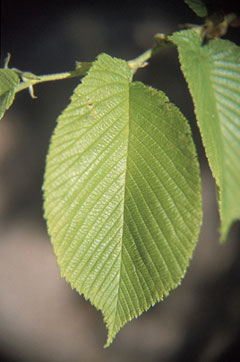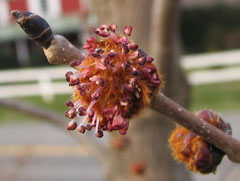 |
|
http://commons.wikimedia.org/wiki/User:Phyzome |
 |
|
Translate this page:
Summary
Physical Characteristics

 Ulmus rubra is a deciduous Tree growing to 20 m (65ft) by 15 m (49ft) at a medium rate.
Ulmus rubra is a deciduous Tree growing to 20 m (65ft) by 15 m (49ft) at a medium rate.
See above for USDA hardiness. It is hardy to UK zone 3 and is not frost tender. It is in flower from March to May, and the seeds ripen from May to June. The species is hermaphrodite (has both male and female organs) and is pollinated by Wind.
Suitable for: light (sandy), medium (loamy) and heavy (clay) soils and prefers well-drained soil. Suitable pH: mildly acid, neutral and basic (mildly alkaline) soils. It can grow in semi-shade (light woodland) or no shade. It prefers moist soil.
UK Hardiness Map
US Hardiness Map
Synonyms
U. fulva. Michx. Ulmus crispa. Willd. Ulmus pendula. Willd.
Plant Habitats
Woodland Garden Canopy;
Edible Uses
Edible Parts: Fruit Inner bark Leaves
Edible Uses: Tea
Leaves - raw or cooked. Inner bark - raw or cooked. It can be dried, ground into a powder and then used as a thickener in soups or added to cereal flours when making bread etc[2, 14, 46, 55, 171]. It can also be chewed as a thirst quencher[227]. The inner bark has been cooked with fats in order to prevent them becoming rancid[257]. Immature fruit - raw or cooked[177]. The fruit is about 20mm in diameter[200]. A tea-like beverage can be brewed from the inner bark[257].
References More on Edible Uses
Medicinal Uses
Plants For A Future can not take any responsibility for any adverse effects from the use of plants. Always seek advice from a professional before using a plant medicinally.
Demulcent Diuretic Emollient Expectorant Nutritive Urinary
Slippery elm bark is a widely used herbal remedy and is considered to be one of the most valuable of remedies in herbal practice[4]. In particular, it is a gentle and effective remedy for irritated states of the mucous membranes of the chest, urinary tubules, stomach and intestines[254]. The inner bark contains large quantities of a sticky slime that can be dried to a powder or made into a liquid[229]. The inner bark is harvested in the spring from the main trunk and from larger branches, it is then dried and powdered for use as required[4]. Ten year old bark is said to be best[4]. Fine grades of the powder are best for internal use, coarse grades are better suited to poultices[238]. The plant is also part of a North American formula called essiac which is a popular treatment for cancer. Its effectiveness has never been reliably proven or disproven since controlled studies have not been carried out. The other herbs included in the formula are Arctium lappa, Rumex acetosella and Rheum palmatum[254]. The inner bark is demulcent, diuretic, emollient, expectorant, nutritive[4, 21, 165, 213]. It has a soothing and healing effect on all parts of the body that it comes into contact with[4] and is used in the treatment of sore throats, indigestion, digestive irritation, stomach ulcers etc[222]. It used to be frequently used as a food that was a nutritive tonic for the old, young and convalescents[222]. It was also applied externally to fresh wounds, burns and scalds[222]. The bark has been used as an antioxidant to prevent fats going rancid[222]. The whole bark, including the outer bark, has been used as a mechanical irritant to abort foetuses[238]. Its use became so widespread that it is now banned in several countries[238].
References More on Medicinal Uses
The Bookshop: Edible Plant Books
Our Latest books on Perennial Plants For Food Forests and Permaculture Gardens in paperback or digital formats.

Edible Tropical Plants
Food Forest Plants for Hotter Conditions: 250+ Plants For Tropical Food Forests & Permaculture Gardens.
More

Edible Temperate Plants
Plants for Your Food Forest: 500 Plants for Temperate Food Forests & Permaculture Gardens.
More

More Books
PFAF have eight books available in paperback and digital formats. Browse the shop for more information.
Shop Now
Other Uses
Fibre Kindling Roofing Tinder Wood
A fibre obtained from the inner bark is used to make a twine[189, 257]. The boiled bark has been used for making matting, nets etc[257]. The inner bark has been used in making baskets[257]. The bark has been used as a roofing material[257]. The weathered bark has been used as kindling for starting a fire[257]. Wood - very close-grained, tough, heavy, hard, strong, durable, easy to split. It weighs 43lb per cubic foot and is used for fence posts, window sills, agricultural implements etc[46, 61, 82, 227].
Special Uses
Carbon Farming Food Forest
References More on Other Uses
Cultivation details
Industrial Crop: Medicinal Management: Coppice Management: Standard Minor Global Crop
Prefers a fertile soil in full sun[188], but can be grown in any soil of at least moderate quality so long as it is well drained[1]. Plants are hardy to about -10°c[238]. A moderately fast-growing tree, living about 200 years in the wild[229], but although perfectly hardy, this species does not usually thrive in Britain[11]. Trees are often harvested in the wild for their edible inner bark, the 'slippery elm' that can be obtained from chemists and health food shops[K]. Trees have been over-exploited in the wild, plus they have also suffered from Dutch elm disease. As a result they are becoming much less common[238]. The slippery elm is very susceptible to 'Dutch elm disease', a disease that has destroyed the greater part of all the elm trees growing in Britain. The disease is spread by means of beetles. There is no effective cure (1992) for the problem, but most E. Asian, though not Himalayan, species are resistant (though not immune) to the disease so the potential exists to use these resistant species to develop new resistant hybrids with the native species[200]. The various species of this genus hybridize freely with each other and pollen is easily saved, so even those species with different flowering times can be hybridized[200]. For polyculture design as well as the above-ground architecture (form - tree, shrub etc. and size shown above) information on the habit and root pattern is also useful and given here if available. The plant growth habit is a standard with a non-suckering single trunk [1-2].
Carbon Farming
-
Industrial Crop: Medicinal
Most pharmaceuticals are synthesized from petroleum but 25% of modern medicines are based on plants.
-
Management: Coppice
Cut to the ground repeatedly - resprouting vigorously. Non-destructive management systems maintaining the soil organic carbon.
-
Management: Standard
Plants grow to their standard height. Harvest fruit, seeds, or other products. Non-Destructive management systems.
-
Minor Global Crop
These crops are already grown or traded around the world, but on a smaller scale than the global perennial staple and industrial crops, The annual value of a minor global crop is under $1 billion US. Examples include shea, carob, Brazil nuts and fibers such as ramie and sisal.
References Carbon Farming Information and Carbon Sequestration Information
Temperature Converter
Type a value in the Celsius field to convert the value to Fahrenheit:
Fahrenheit:
The PFAF Bookshop
Plants For A Future have a number of books available in paperback and digital form. Book titles include Edible Plants, Edible Perennials, Edible Trees,Edible Shrubs, Woodland Gardening, and Temperate Food Forest Plants. Our new book is Food Forest Plants For Hotter Conditions (Tropical and Sub-Tropical).
Shop Now
Plant Propagation
Seed - if sown in a cold frame as soon as it is ripe, it usually germinates within a few days[200]. Stored seed does not germinate so well and should be sown in early spring[200], it requires 2 - 3 months stratification according to another report[113]. The seed can also be harvested 'green' (when it has fully developed but before it dries on the tree) and sown immediately in a cold frame. It should germinate very quickly and will produce a larger plant by the end of the growing season[80]. When they are large enough to handle, prick the seedlings out into individual pots and grow them on in the greenhouse for their first winter. Plant them out into their permanent positions in late spring or early summer, after the last expected frosts. Plants should not be allowed to grow for more than two years in a nursery bed since they form a tap root and will then move badly. Layering of suckers or coppiced shoots[200].
Other Names
If available other names are mentioned here
Native Range
NORTHERN AMERICA: Canada, Québec, Ontario, United States, Connecticut, Indiana, Maine, Massachusetts, Michigan, New Hampshire, New Jersey, New York, Ohio, Pennsylvania, Vermont, West Virginia, Illinois, Iowa, Kansas, Minnesota, Missouri, Nebraska, North Dakota, Oklahoma, South Dakota, Wisconsin, Alabama, Arkansas, Delaware, Florida, Georgia, Kentucky, Louisiana, Maryland, Mississippi, North Carolina, South Carolina, Tennessee, Virginia, District of Columbia, Texas,
Weed Potential
Right plant wrong place. We are currently updating this section.
Please note that a plant may be invasive in one area but may not in your area so it's worth checking.
Conservation Status
IUCN Red List of Threatened Plants Status :

Growth: S = slow M = medium F = fast. Soil: L = light (sandy) M = medium H = heavy (clay). pH: A = acid N = neutral B = basic (alkaline). Shade: F = full shade S = semi-shade N = no shade. Moisture: D = dry M = Moist We = wet Wa = water.
Now available:
Food Forest Plants for Mediterranean Conditions
350+ Perennial Plants For Mediterranean and Drier Food Forests and Permaculture Gardens.
[Paperback and eBook]
This is the third in Plants For A Future's series of plant guides for food forests tailored to
specific climate zones. Following volumes on temperate and tropical ecosystems, this book focuses
on species suited to Mediterranean conditions—regions with hot, dry summers and cool, wet winters,
often facing the added challenge of climate change.
Read More
Expert comment
Author
Muhl.
Botanical References
1143200
Links / References
For a list of references used on this page please go here
Readers comment